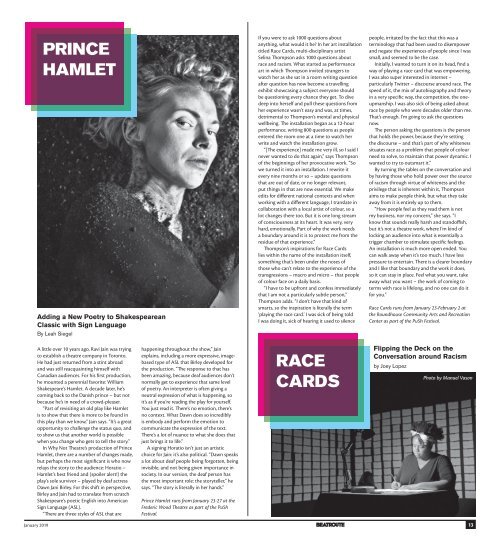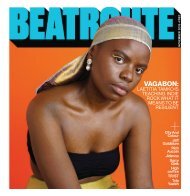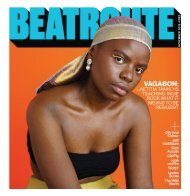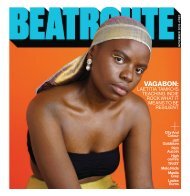BeatRoute Magazine BC Edition January 2019
BeatRoute Magazine is a monthly arts and entertainment paper with a predominant focus on music – local, independent or otherwise. The paper started in June 2004 and continues to provide a healthy dose of perversity while exercising rock ‘n’ roll ethics. Currently BeatRoute’s AB edition is distributed in Calgary, Edmonton (by S*A*R*G*E), Banff and Canmore. The BC edition is distributed in Vancouver, Victoria and Nanaimo. BeatRoute (AB) Mission PO 23045 Calgary, AB T2S 3A8 E. editor@beatroute.ca BeatRoute (BC) #202 – 2405 E Hastings Vancouver, BC V5K 1Y8 P. 778-888-1120
BeatRoute Magazine is a monthly arts and entertainment paper with a predominant focus on music – local, independent or otherwise. The paper started in June 2004 and continues to provide a healthy dose of perversity while exercising rock ‘n’ roll ethics.
Currently BeatRoute’s AB edition is distributed in Calgary, Edmonton (by S*A*R*G*E), Banff and Canmore. The BC edition is distributed in Vancouver, Victoria and Nanaimo. BeatRoute (AB) Mission PO 23045 Calgary, AB T2S 3A8 E. editor@beatroute.ca BeatRoute (BC) #202 – 2405 E Hastings Vancouver, BC V5K 1Y8 P. 778-888-1120
Create successful ePaper yourself
Turn your PDF publications into a flip-book with our unique Google optimized e-Paper software.
PRINCE<br />
HAMLET<br />
Adding a New Poetry to Shakespearean<br />
Classic with Sign Language<br />
By Leah Siegel<br />
If you were to ask 1000 questions about<br />
anything, what would it be? In her art installation<br />
titled Race Cards, multi-disciplinary artist<br />
Selina Thompson asks 1000 questions about<br />
race and racism. What started as performance<br />
art in which Thompson invited strangers to<br />
watch her as she sat in a room writing question<br />
after question has now become a travelling<br />
exhibit showcasing a subject everyone should<br />
be questioning every chance they get. To dive<br />
deep into herself and pull these questions from<br />
her experience wasn’t easy and was, at times,<br />
detrimental to Thompson’s mental and physical<br />
wellbeing. The installation began as a 12-hour<br />
performance, writing 800 questions as people<br />
entered the room one at a time to watch her<br />
write and watch the installation grow.<br />
“[The experience] made me very ill, so I said I<br />
never wanted to do that again,” says Thompson<br />
of the beginnings of her provocative work. “So<br />
we turned it into an installation. I rewrite it<br />
every nine months or so – update questions<br />
that are out of date, or no longer relevant,<br />
put things in that are now essential. We make<br />
edits for different national contexts and when<br />
working with a different language, I translate in<br />
collaboration with a local artist of colour, so a<br />
lot changes there too. But it is one long stream<br />
of consciousness at its heart. It was very, very<br />
hard, emotionally. Part of why the work needs<br />
a boundary around it is to protect me from the<br />
residue of that experience.”<br />
Thompson’s inspirations for Race Cards<br />
lies within the name of the installation itself,<br />
something that’s been under the noses of<br />
those who can’t relate to the experience of the<br />
transgressions – macro and micro – that people<br />
of colour face on a daily basis.<br />
“I have to be upfront and confess immediately<br />
that I am not a particularly subtle person,”<br />
Thompson adds. “I don’t have that kind of<br />
smarts, so the inspiration is literally the term<br />
‘playing the race card.’ I was sick of being told<br />
I was doing it, sick of hearing it used to silence<br />
people, irritated by the fact that this was a<br />
terminology that had been used to disempower<br />
and negate the experiences of people since I was<br />
small, and seemed to be the case.<br />
Initially, I wanted to turn it on its head, find a<br />
way of playing a race card that was empowering.<br />
I was also super interested in internet –<br />
particularly Twitter – discourse around race. The<br />
speed of it, the mix of autobiography and theory<br />
in a very specific way, the competition, the oneupmanship.<br />
I was also sick of being asked about<br />
race by people who were decades older than me.<br />
That’s enough. I’m going to ask the questions<br />
now.<br />
The person asking the questions is the person<br />
that holds the power, because they’re setting<br />
the discourse – and that’s part of why whiteness<br />
situates race as a problem that people of colour<br />
need to solve, to maintain that power dynamic. I<br />
wanted to try to outsmart it.”<br />
By turning the tables on the conversation and<br />
by having those who hold power over the source<br />
of racism through virtue of whiteness and the<br />
privilege that is inherent within it, Thompson<br />
aims to make people think, but what they take<br />
away from it is entirely up to them.<br />
“How people feel as they read them is not<br />
my business, nor my concern,” she says. “I<br />
know that sounds really harsh and standoffish,<br />
but it’s not a theatre work, where I’m kind of<br />
locking an audience into what is essentially a<br />
trigger chamber to stimulate specific feelings.<br />
An installation is much more open ended. You<br />
can walk away when it’s too much. I have less<br />
pressure to entertain. There is a clearer boundary<br />
and I like that boundary and the work it does,<br />
so it can stay in place. Feel what you want, take<br />
away what you want – the work of coming to<br />
terms with race is lifelong, and no one can do it<br />
for you.”<br />
Race Cards runs from <strong>January</strong> 23-February 2 at<br />
the Roundhouse Community Arts and Recreation<br />
Center as part of the PuSh Festival.<br />
A little over 10 years ago, Ravi Jain was trying<br />
to establish a theatre company in Toronto.<br />
He had just returned from a stint abroad<br />
and was still reacquainting himself with<br />
Canadian audiences. For his first production,<br />
he mounted a perennial favorite: William<br />
Shakespeare’s Hamlet. A decade later, he’s<br />
coming back to the Danish prince – but not<br />
because he’s in need of a crowd-pleaser.<br />
“Part of revisiting an old play like Hamlet<br />
is to show that there is more to be found in<br />
this play than we know,” Jain says. “It’s a great<br />
opportunity to challenge the status quo, and<br />
to show us that another world is possible<br />
when you change who gets to tell the story.”<br />
In Why Not Theatre’s production of Prince<br />
Hamlet, there are a number of changes made,<br />
but perhaps the most significant is who now<br />
relays the story to the audience: Horatio –<br />
Hamlet’s best friend and (spoiler alert!) the<br />
play’s sole survivor – played by deaf actress<br />
Dawn Jani Birley. For this shift in perspective,<br />
Birley and Jain had to translate from scratch<br />
Shakespeare’s poetic English into American<br />
Sign Language (ASL).<br />
“There are three styles of ASL that are<br />
happening throughout the show,” Jain<br />
explains, including a more expressive, imagebased<br />
type of ASL that Birley developed for<br />
the production. “The response to that has<br />
been amazing, because deaf audiences don’t<br />
normally get to experience that same level<br />
of poetry. An interpreter is often giving a<br />
neutral expression of what is happening, so<br />
it’s as if you’re reading the play for yourself.<br />
You just read it. There’s no emotion, there’s<br />
no context. What Dawn does so incredibly<br />
is embody and perform the emotion to<br />
communicate the expression of the text.<br />
There’s a lot of nuance to what she does that<br />
just brings it to life.”<br />
A signing Horatio isn’t just an artistic<br />
choice for Jain: it’s also political. “Dawn speaks<br />
a lot about deaf people being forgotten, being<br />
invisible, and not being given importance in<br />
society. In our version, the deaf person has<br />
the most important role: the storyteller,” he<br />
says. “The story is literally in her hands.”<br />
Prince Hamlet runs from <strong>January</strong> 23-27 at the<br />
Frederic Wood Theatre as part of the PuSh<br />
Festival.<br />
RACE<br />
CARDS<br />
Flipping the Deck on the<br />
Conversation around Racism<br />
by Joey Lopez<br />
Photo by Manuel Vason<br />
<strong>January</strong> <strong>2019</strong> 13


















